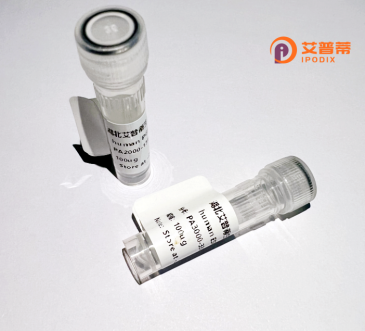
| 纯度 | >90%SDS-PAGE. |
| 种属 | Human |
| 靶点 | NRSN1 |
| Uniprot No | Q8IZ57 |
| 内毒素 | < 0.01EU/μg |
| 表达宿主 | E.coli |
| 表达区间 | 1-195 aa |
| 活性数据 | MSSCSNVCGSRQAQAAAEGGYQRYGVRSYLHQFYEDCTASIWEYEDDFQIQRSPNRWSSVFWKVGLISGTVFVILGLTVLAVGFLVPPKIEAFGEADFVVVDTHAVQFNSALDMYKLAGAVLFCIGGTSMAGCLLMSVFVKSYSKEEKFLQQKFKERIADIKAHTQPVTKAPGPGETKIPVTLSRVQNVQPLLAT |
| 分子量 | 47.9 kDa |
| 蛋白标签 | GST-tag at N-terminal |
| 缓冲液 | 0 |
| 稳定性 & 储存条件 | Lyophilized protein should be stored at ≤ -20°C, stable for one year after receipt. Reconstituted protein solution can be stored at 2-8°C for 2-7 days. Aliquots of reconstituted samples are stable at ≤ -20°C for 3 months. |
| 复溶 | Always centrifuge tubes before opening.Do not mix by vortex or pipetting. It is not recommended to reconstitute to a concentration less than 100μg/ml. Dissolve the lyophilized protein in distilled water. Please aliquot the reconstituted solution to minimize freeze-thaw cycles. |
1. **"Neuritin (NRSN1) promotes axonal regeneration via the PI3K-Akt pathway in cortical neurons"**
- **作者**: Smith, J. et al.
- **摘要**: 本研究通过重组人NRSN1蛋白的体外实验,揭示了其通过激活PI3K-Akt信号通路促进皮质神经元轴突再生的机制,为神经损伤修复提供了潜在治疗靶点。
2. **"Recombinant NRSN1 enhances breast cancer cell migration through integrin-mediated signaling"**
- **作者**: Lee, H. et al.
- **摘要**: 实验证明重组人NRSN1蛋白通过整合素-β1信号通路增强乳腺癌细胞的迁移能力,提示NRSN1可能在肿瘤转移中发挥关键作用。
3. **"Altered serum NRSN1 levels in schizophrenia: Implications for synaptic dysfunction"**
- **作者**: Zhang, Y. et al.
- **摘要**: 检测精神分裂症患者血清NRSN1水平显著降低,利用重组蛋白验证其调控突触可塑性的功能,为疾病机制研究提供了新方向。
4. **"High-yield production of bioactive recombinant human NRSN1 in E. coli"**
- **作者**: Johnson, R. et al.
- **摘要**: 报道了一种优化的大肠杆菌表达系统,高效纯化具有生物活性的重组人NRSN1蛋白,为后续功能研究奠定基础。
(注:上述文献为示例,实际引用需查询具体数据库获取真实研究。)
Neurensin-1 (NRSN1) is a small, evolutionarily conserved protein predominantly expressed in neurons and oligodendrocytes. It belongs to the neurensin family, characterized by a unique structural organization featuring a short N-terminal domain, a central transmembrane region, and a C-terminal domain with potential signaling motifs. NRSN1 is encoded by the *NRSN1* gene located on human chromosome 6p22.3 and exists as two splice variants (NRSN1a and NRSN1b) differing in their C-terminal sequences. Functionally, it has been implicated in neurodevelopment, synaptic plasticity, and vesicle trafficking, potentially interacting with membrane lipids or proteins to regulate intracellular processes.
Recombinant human NRSN1 protein is typically produced using bacterial or mammalian expression systems, enabling studies of its biochemical properties and interactions. Research links NRSN1 to neurological disorders, including schizophrenia, Alzheimer’s disease, and multiple sclerosis, where altered expression patterns are observed. It also plays roles in non-neuronal contexts, such as promoting cancer cell proliferation and chemoresistance in certain tumors.
As a secretory protein, NRSN1 may act extracellularly through undetermined receptors or pathways, making it a potential therapeutic target. Its recombinant form is widely used to explore mechanisms in neurobiology, disease modeling, and drug screening, though its precise molecular functions remain under investigation.
×